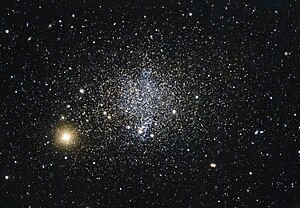astro.wikisort.org - Galaxy
The Phoenix Dwarf is a dwarf irregular galaxy discovered in 1976 by Hans-Emil Schuster and Richard Martin West and mistaken for a globular cluster.[5][6] It is currently 1.44 Mly away from Earth. Its name comes from the fact that it is part of the Phoenix constellation.
| Phoenix Dwarf Galaxy | |
|---|---|
 Phoenix Dwarf by the Very Large Telescope[1] | |
| Observation data (J2000 epoch) | |
| Constellation | Phoenix |
| Right ascension | 01h 51m 06.3s[2] |
| Declination | −44° 26′ 41″[2] |
| Redshift | 60 ± 30 km/s[2] |
| Distance | 1.44 ± 0.07 Mly (440 ± 20 kpc)[3][4] |
| Apparent magnitude (V) | 13.1[2] |
| Characteristics | |
| Type | IAm[2] |
| Apparent size (V) | 4′.9 × 4′.1[2] |
| Notable features | - |
| Other designations | |
| ESO 245- G 007,[2] PGC 6830[2] | |
Characteristics
The Phoenix Dwarf has an inner part of young stars which is stretched in an east-west direction and an outer part of mainly old stars that is stretched north-south. The central region's rate of star formation seems to have been relatively constant across time (Martínez-Delgado et al. 1999). In 1999, St-Germain et al. discovered a H I region of about 105 M☉ just to the west of Phoenix. Its radial velocity is −23 km/s and may be physically associated with Phoenix if it is found to have a similar radial velocity.[7]
References
- "An explosive phoenix". www.eso.org. Retrieved 17 September 2018.
- "NASA/IPAC Extragalactic Database". Results for Phoenix Dwarf. Retrieved 2007-03-15.
- I. D. Karachentsev; V. E. Karachentseva; W. K. Hutchmeier; D. I. Makarov (2004). "A Catalog of Neighboring Galaxies". Astronomical Journal. 127 (4): 2031–2068. Bibcode:2004AJ....127.2031K. doi:10.1086/382905.
- Karachentsev, I. D.; Kashibadze, O. G. (2006). "Masses of the local group and of the M81 group estimated from distortions in the local velocity field". Astrophysics. 49 (1): 3–18. Bibcode:2006Ap.....49....3K. doi:10.1007/s10511-006-0002-6.
- Schuster, H.-E.; West, R. M. (May 1976). "A very distant globular cluster?". Astronomy & Astrophysics. 49: 129–131. Bibcode:1976A&A....49..129S.
- Canterna, R.; Flower, P. J. (March 1977). "A new dwarf irregular galaxy in the constellation Phoenix". Astrophysical Journal. 212 (Letters): L57–L58. Bibcode:1977ApJ...212L..57C. doi:10.1086/182374.
- van den Bergh, Sidney (April 2000). "Updated Information on the Local Group". The Publications of the Astronomical Society of the Pacific. 112 (770): 529–536. arXiv:astro-ph/0001040. Bibcode:2000PASP..112..529V. doi:10.1086/316548.
External links
 Media related to Phoenix Dwarf at Wikimedia Commons
Media related to Phoenix Dwarf at Wikimedia Commons- The Phoenix Dwarf on WikiSky: DSS2, SDSS, GALEX, IRAS, Hydrogen α, X-Ray, Astrophoto, Sky Map, Articles and images
На других языках
[de] Phoenix-Zwerggalaxie
Die Phoenix-Zwerggalaxie ist eine irreguläre Zwerggalaxie im Sternbild des Phönix, die 1976 von Hans-Emil Schuster und Richard Martin West entdeckt und zunächst fälschlicherweise für einen Kugelsternhaufen gehalten wurde.[4][5] Sie befindet sich in einer Entfernung von etwa 0,44 Mpc von der Erde und gehört zur Lokalen Gruppe.- [en] Phoenix Dwarf
[es] Enana de Fénix
La Enana de Fénix es una galaxia enana e irregular que fue descubierta en 1976 por Hans-Emil Schuster y Richard Martin West, fue confundida con un cúmulo globular.[1][2] En la actualidad se halla a 1,44 millones de años luz de la Tierra. Se llama así porque se encuentra en la constelación de Fénix.[ru] Карликовая галактика в Фениксе
Карликовая галактика в Фениксе (англ. Phoenix Dwarf) — карликовая галактика в созвездии Феникса, входящая в состав Местной группы. По своей форме она принадлежит к типу неправильных галактик.Другой контент может иметь иную лицензию. Перед использованием материалов сайта WikiSort.org внимательно изучите правила лицензирования конкретных элементов наполнения сайта.
WikiSort.org - проект по пересортировке и дополнению контента Википедии
